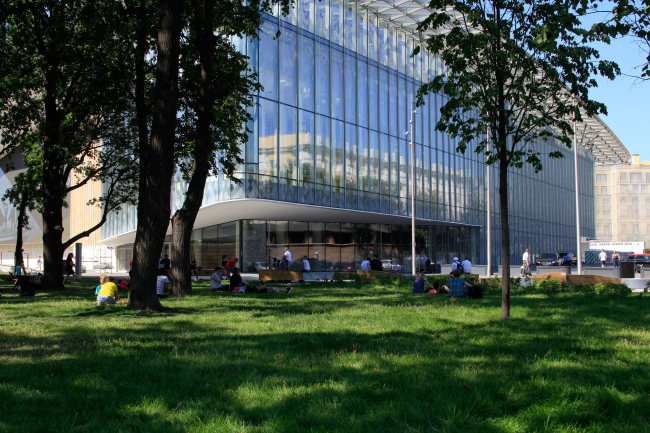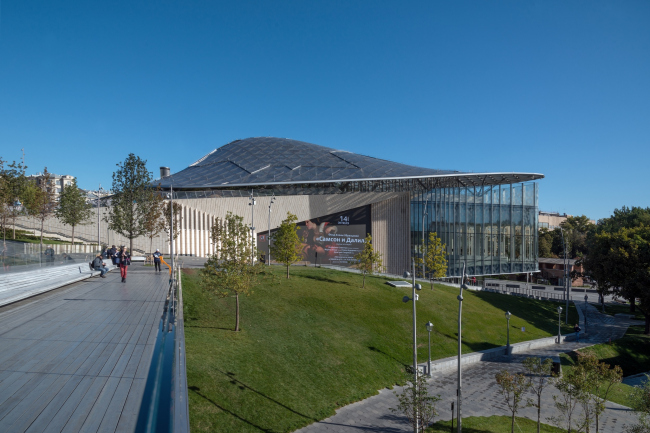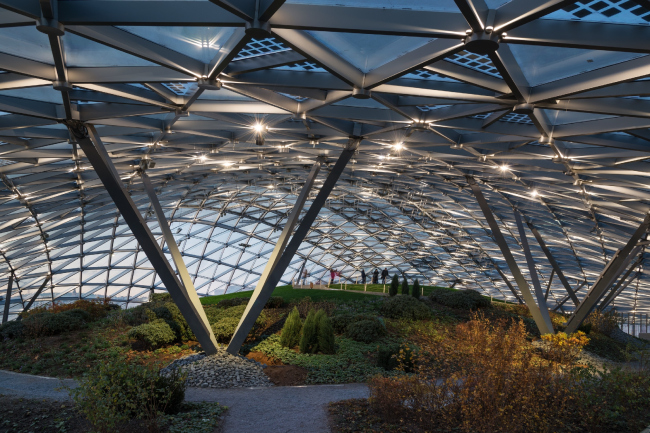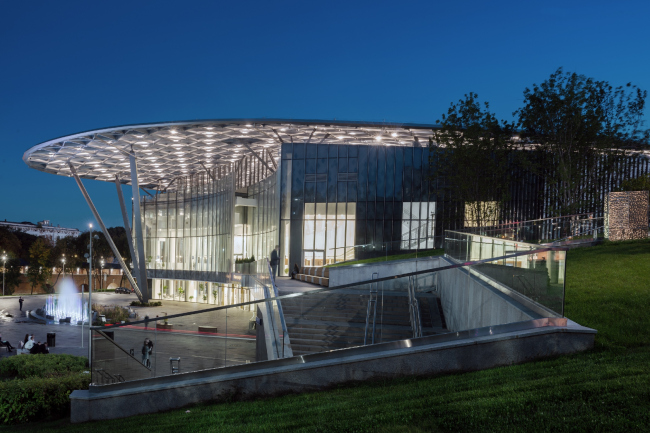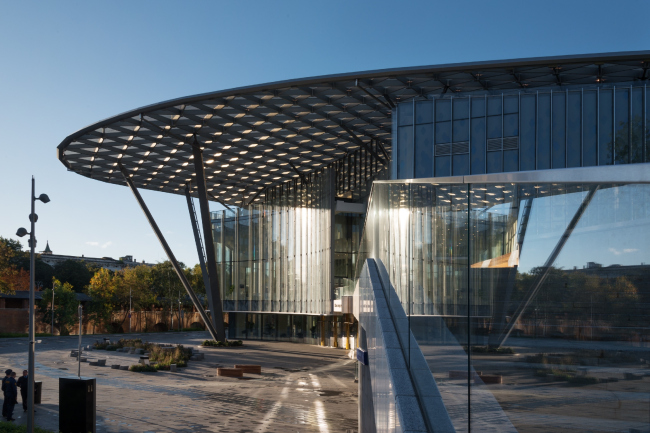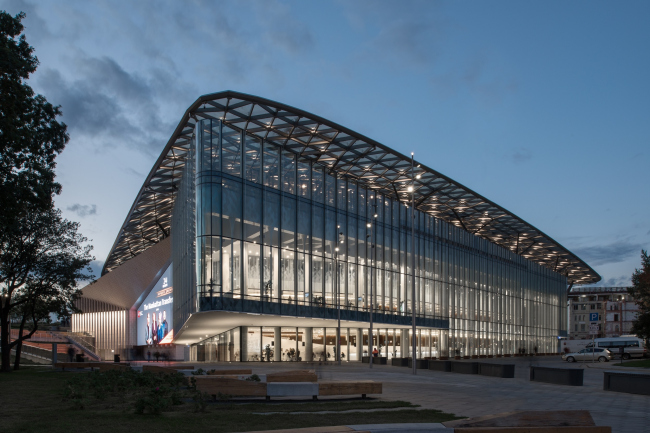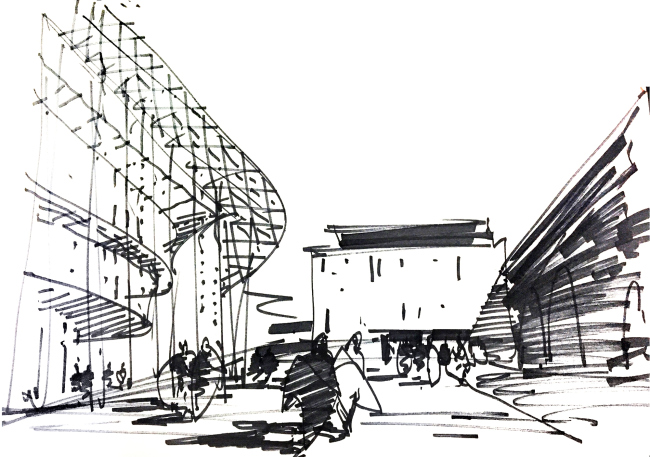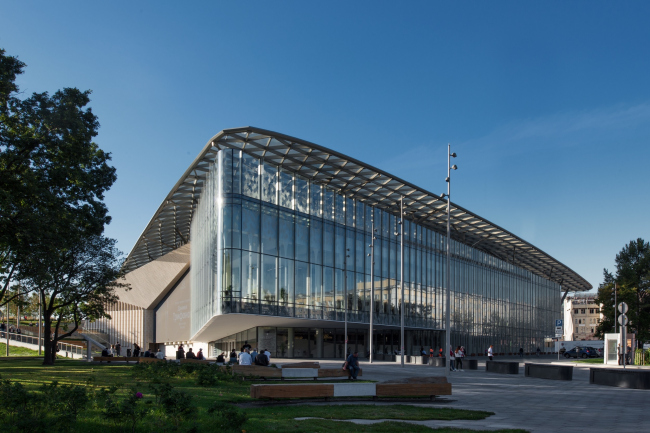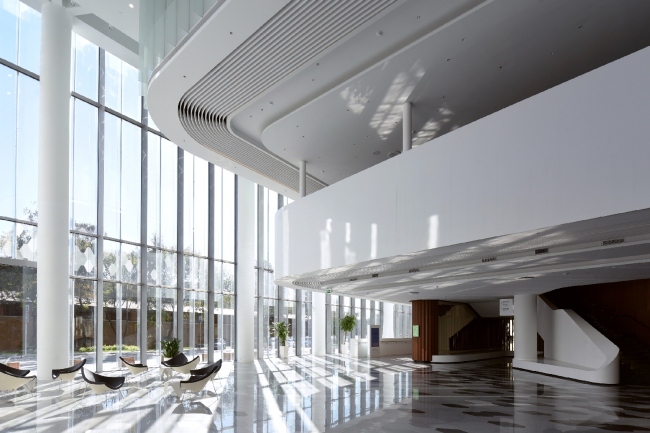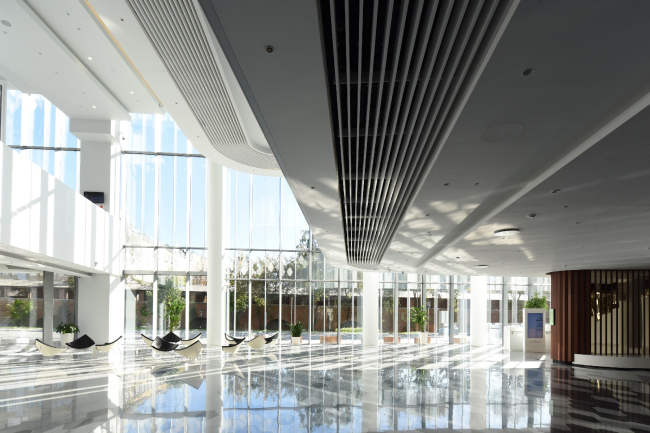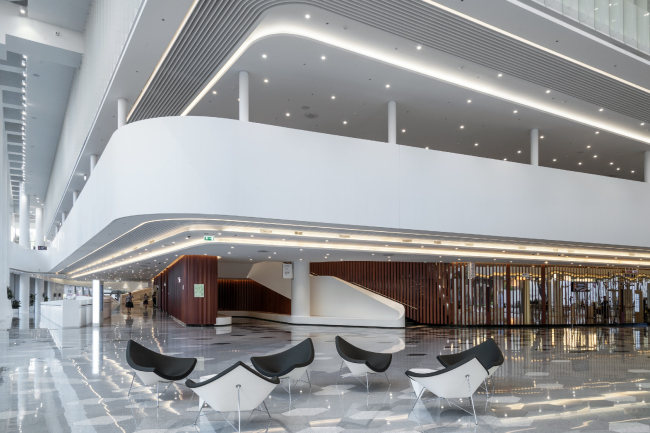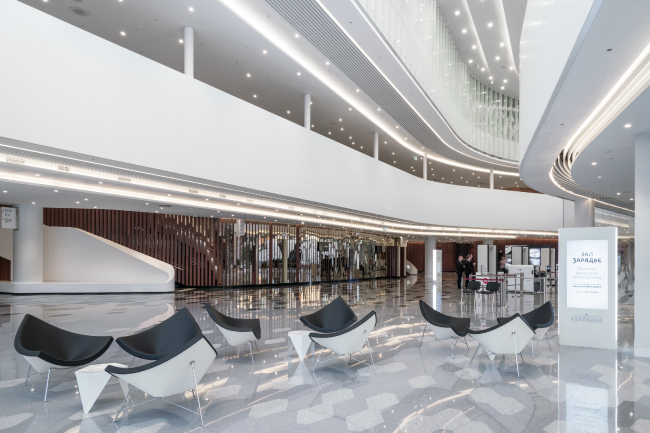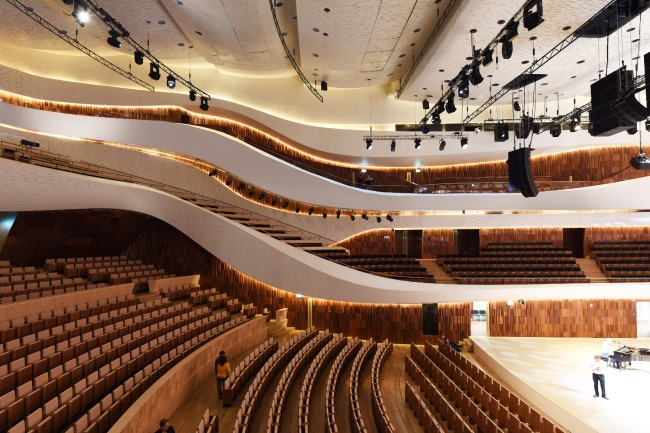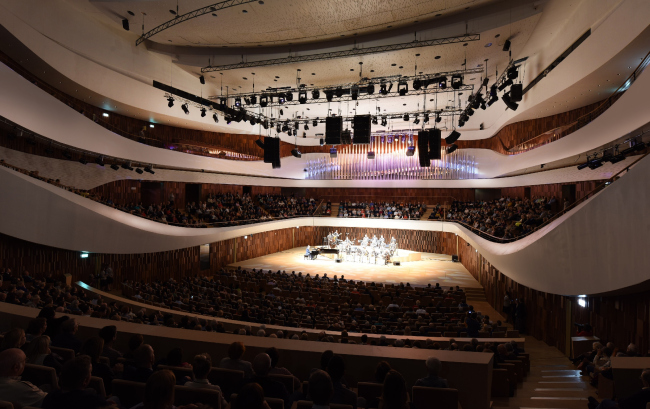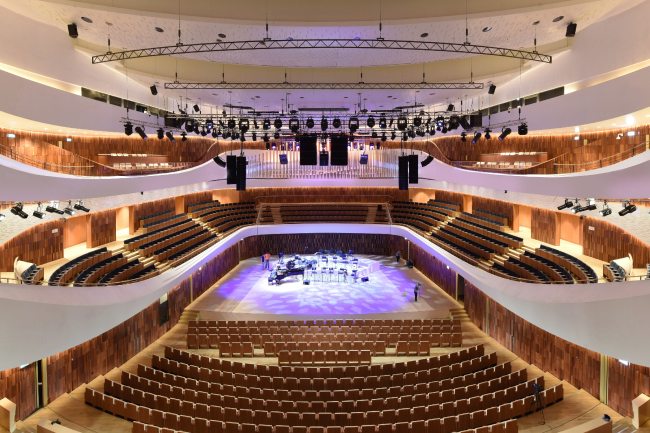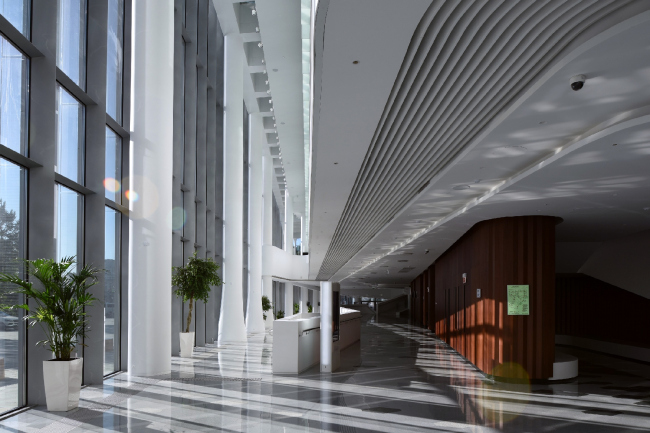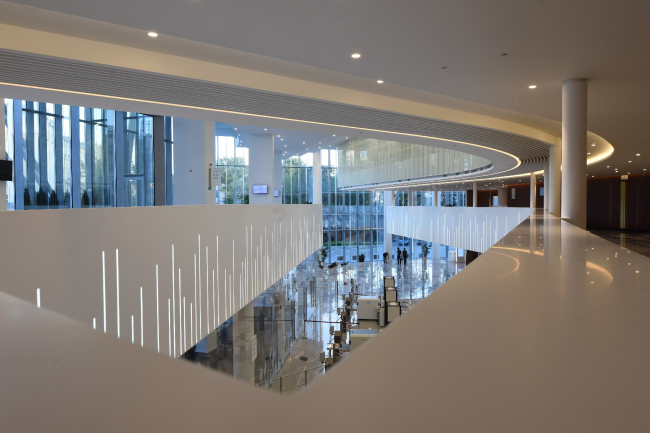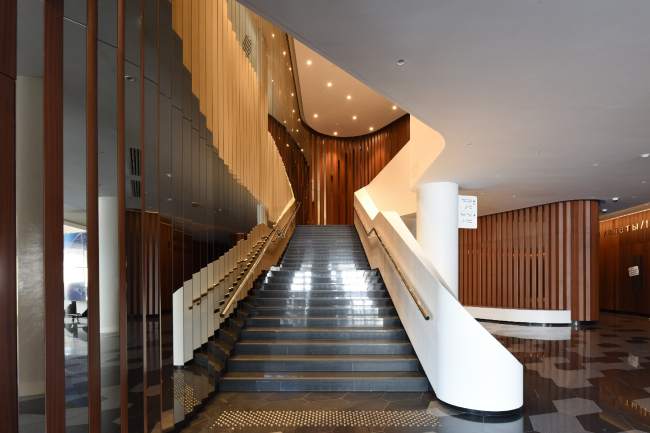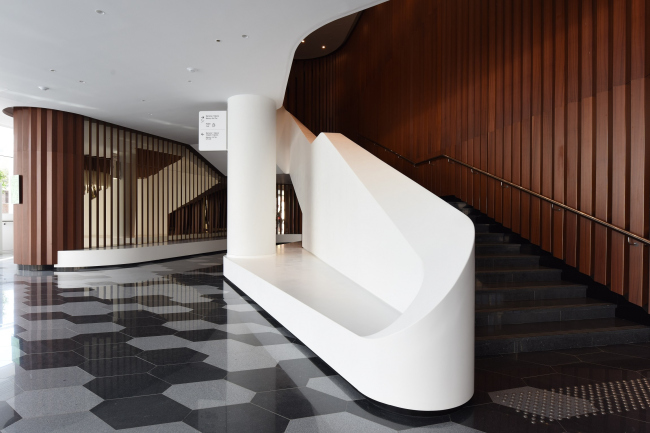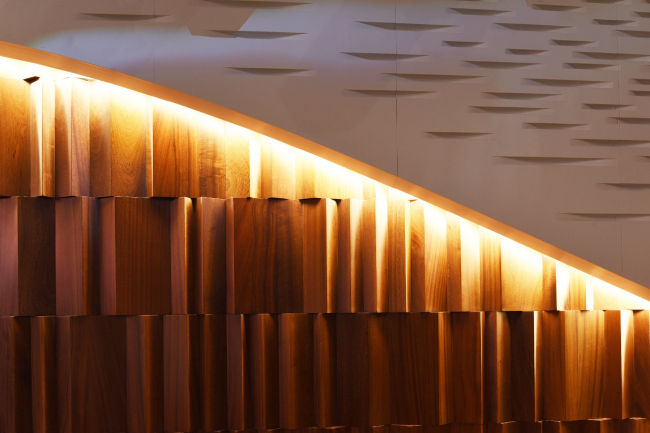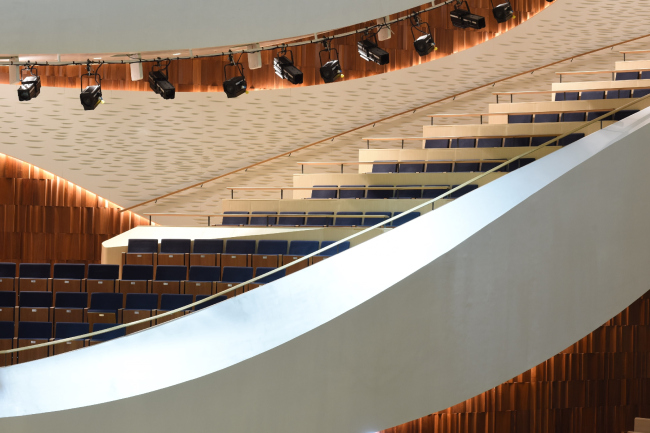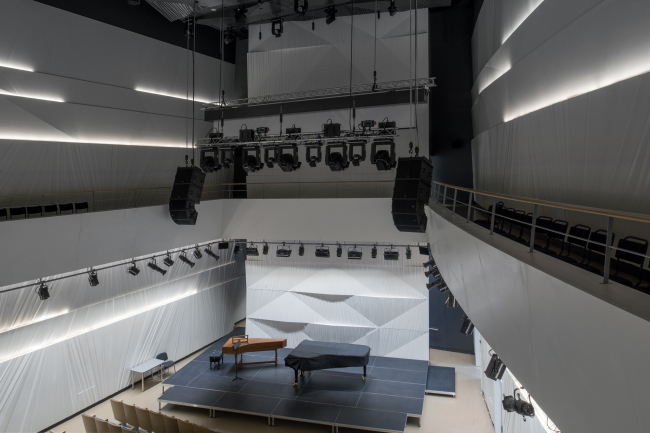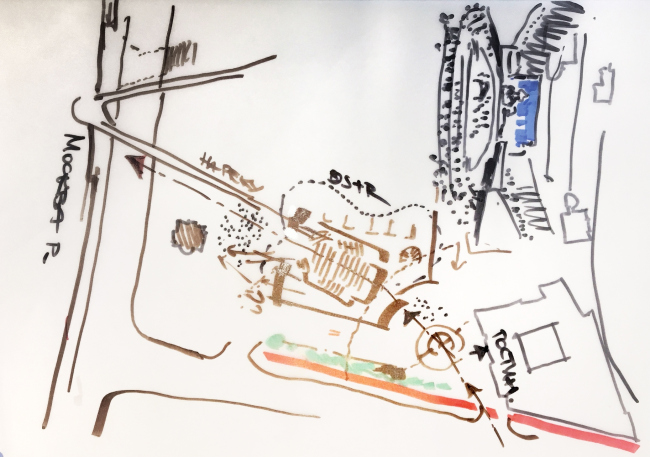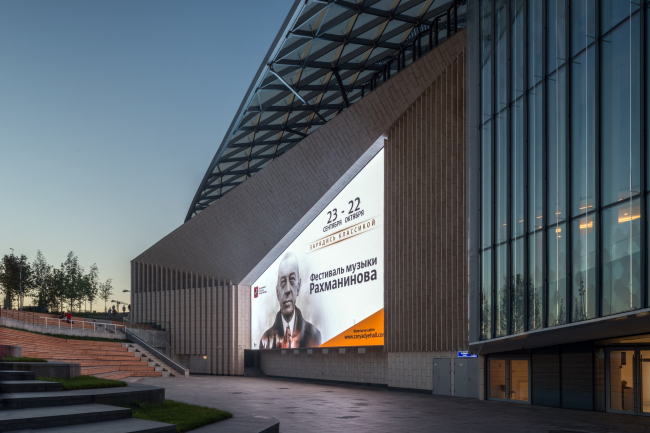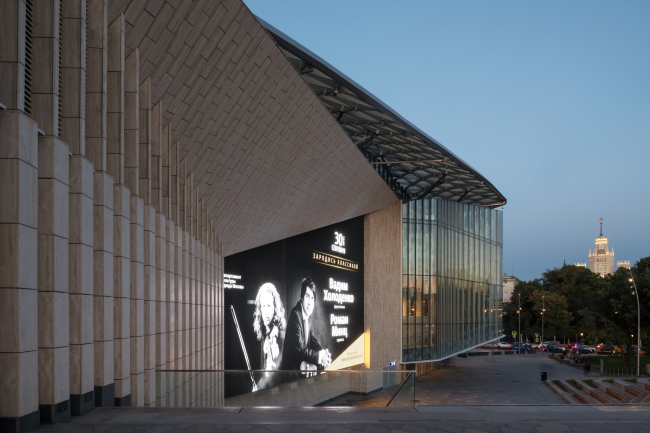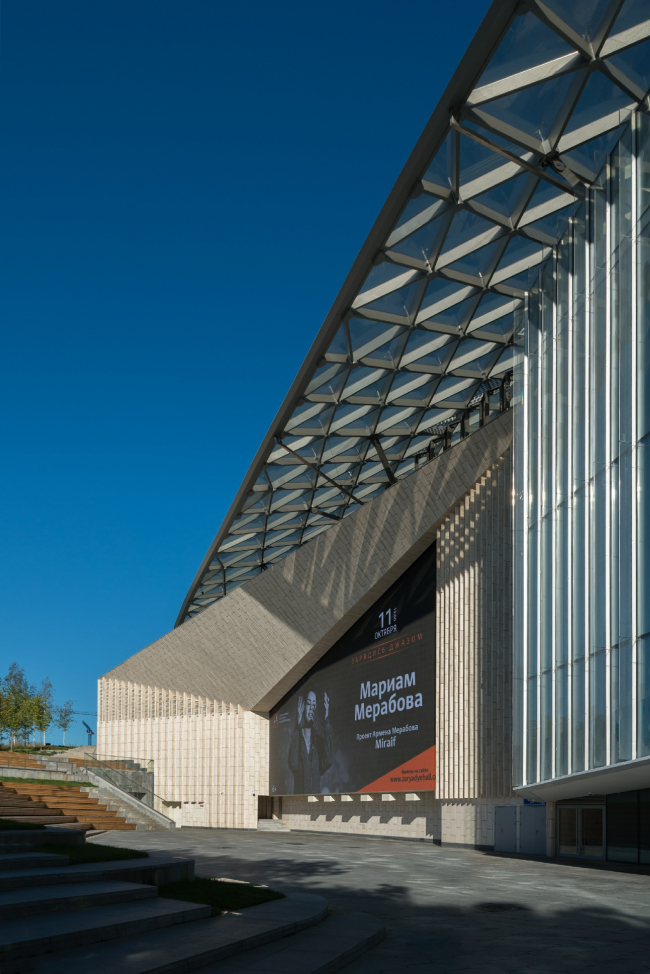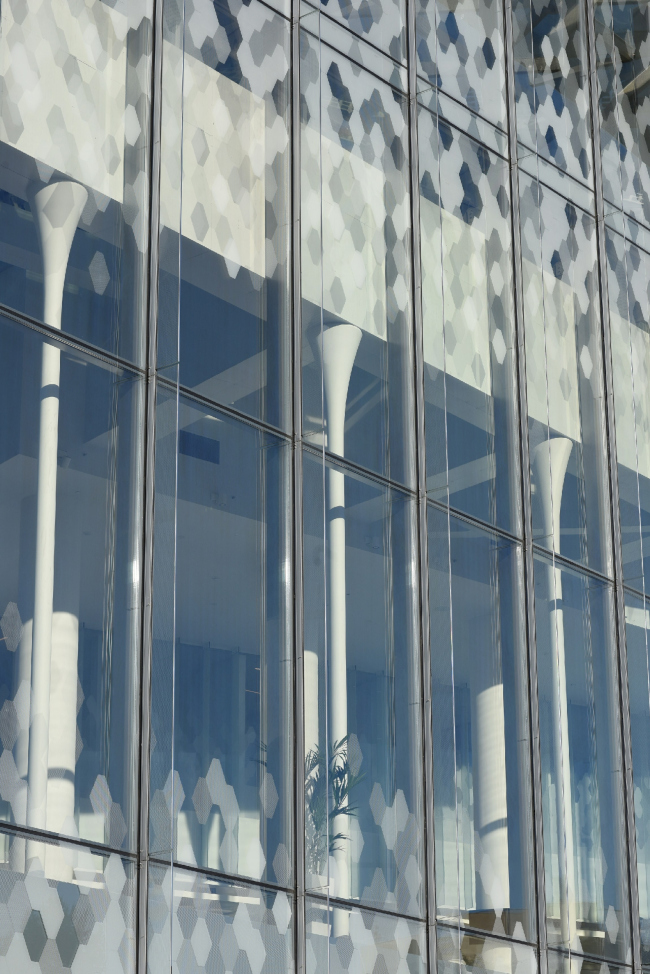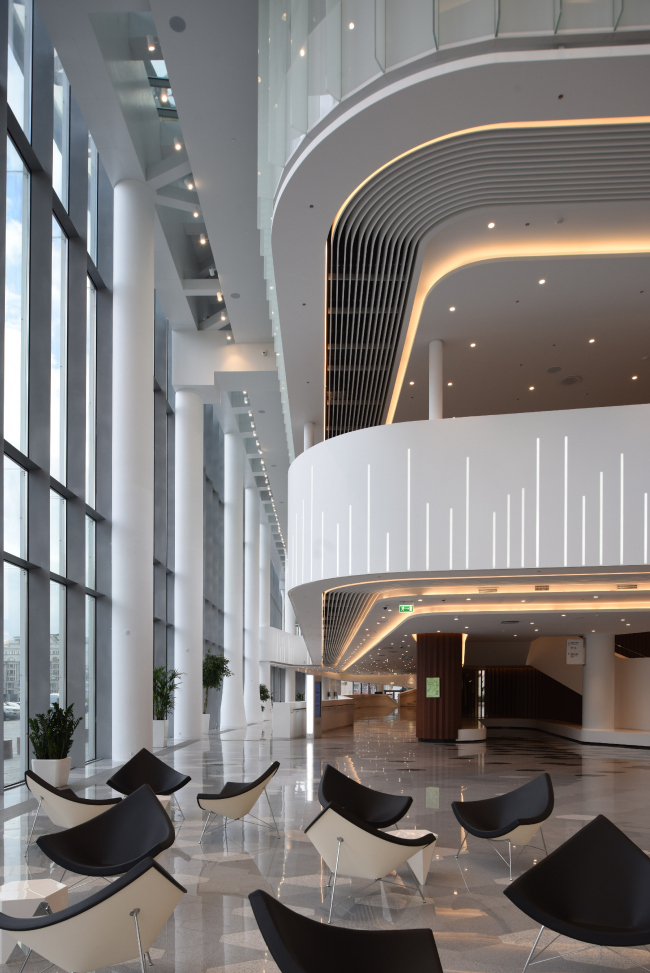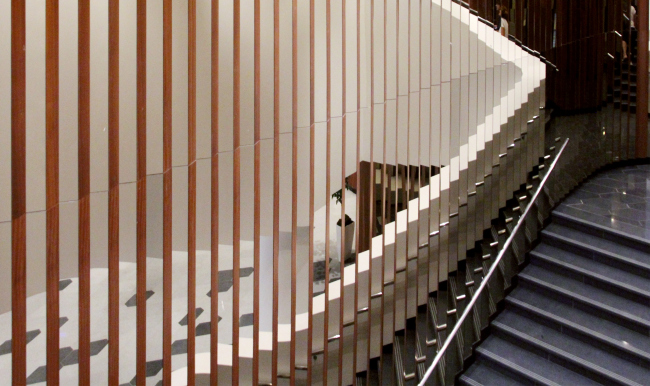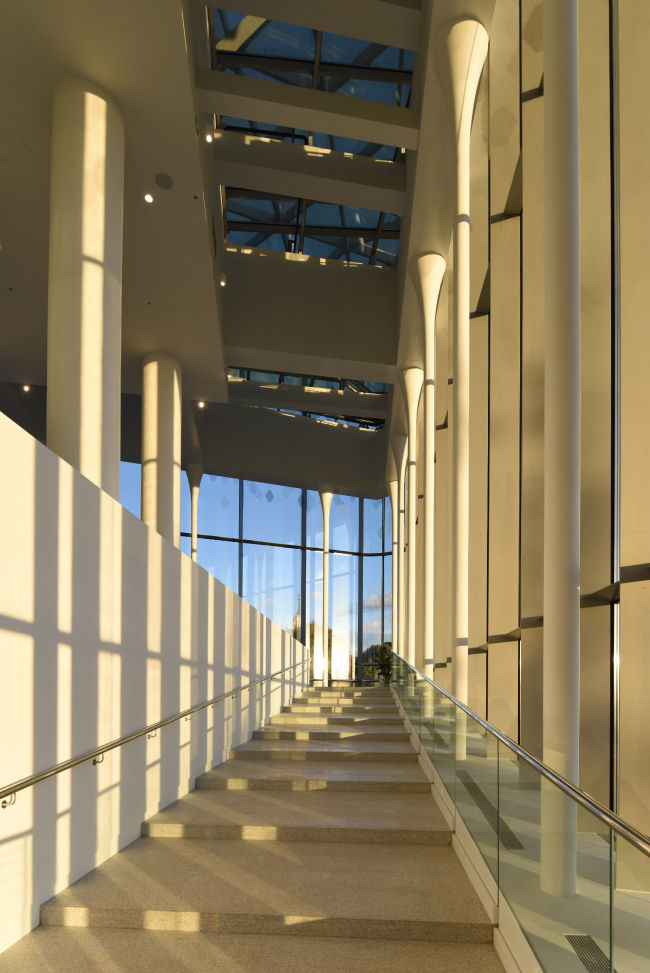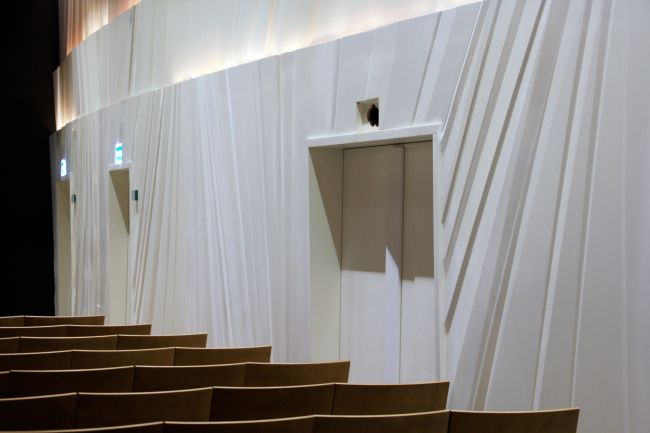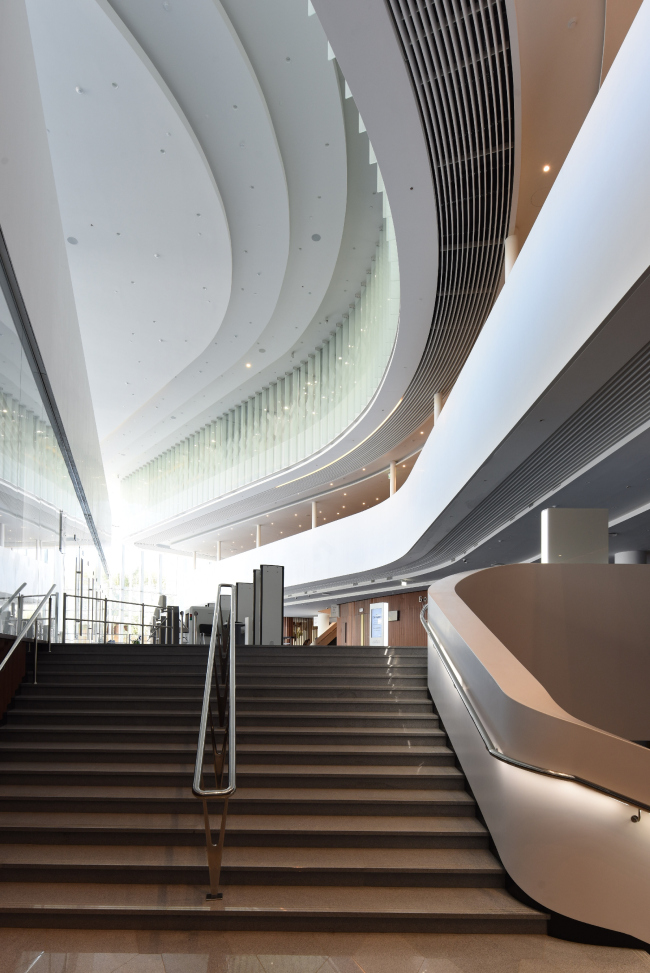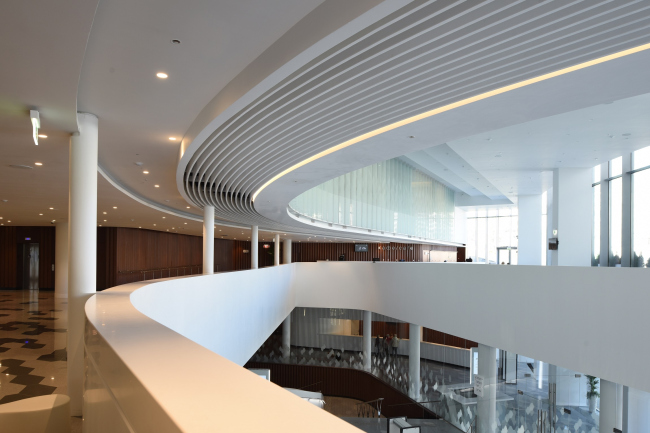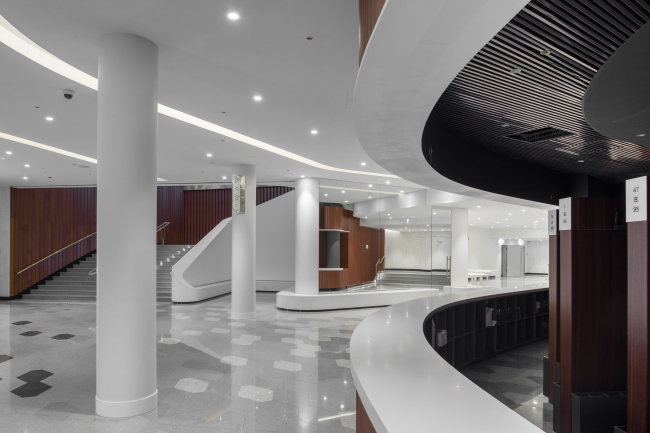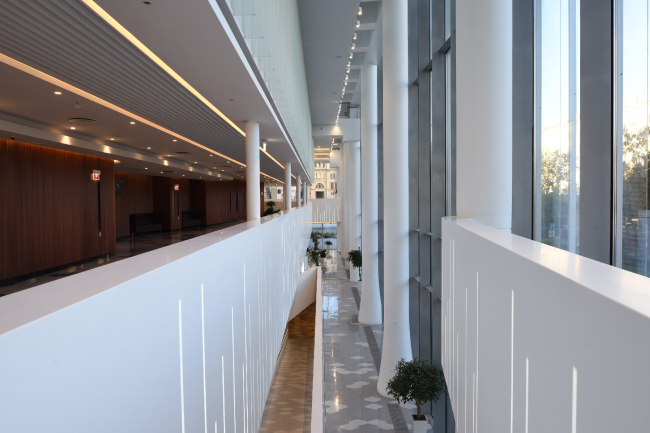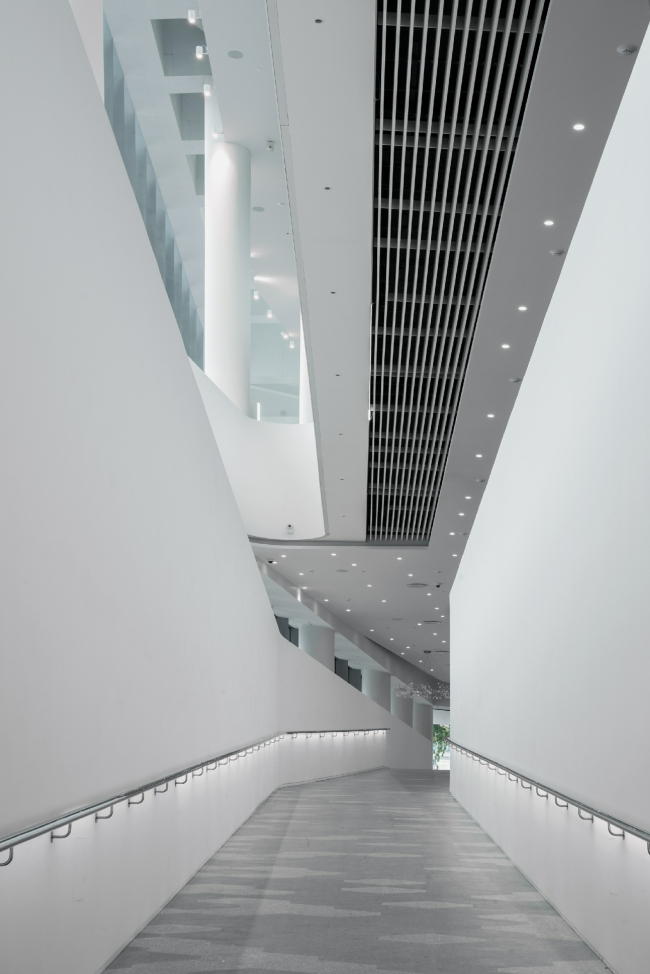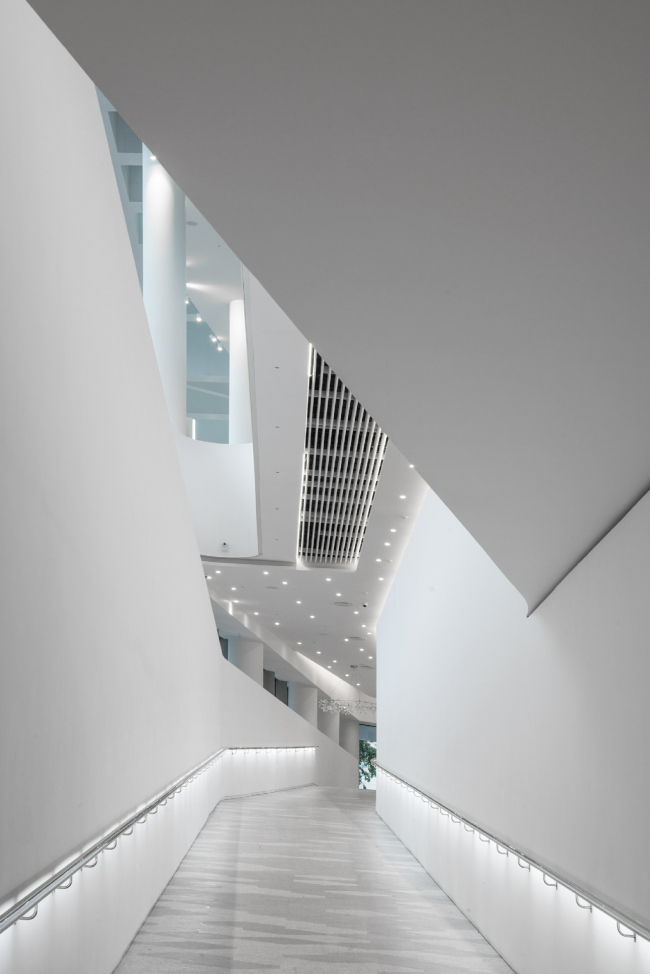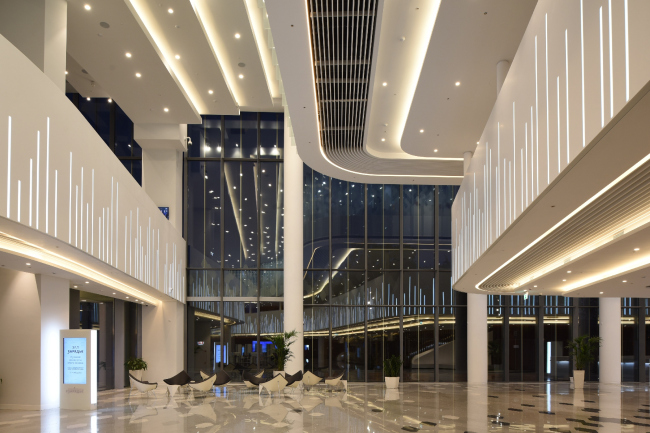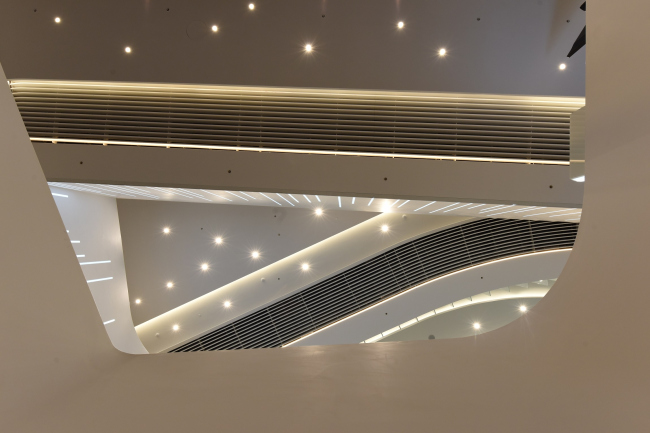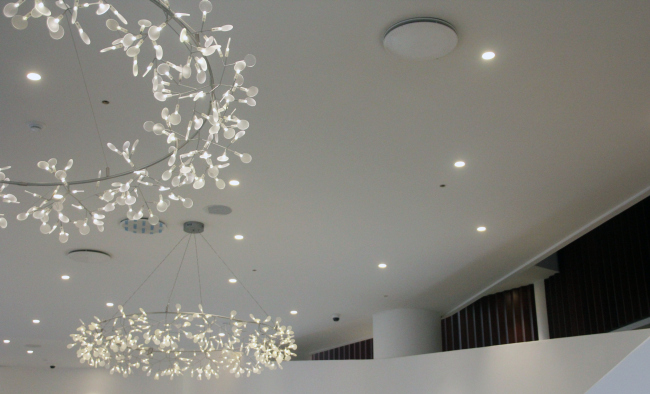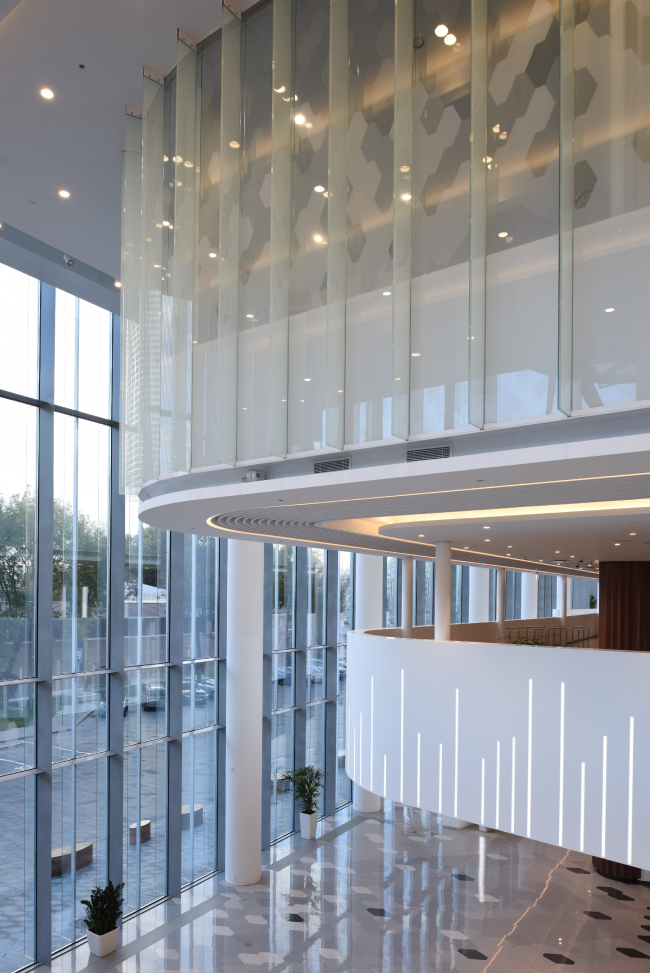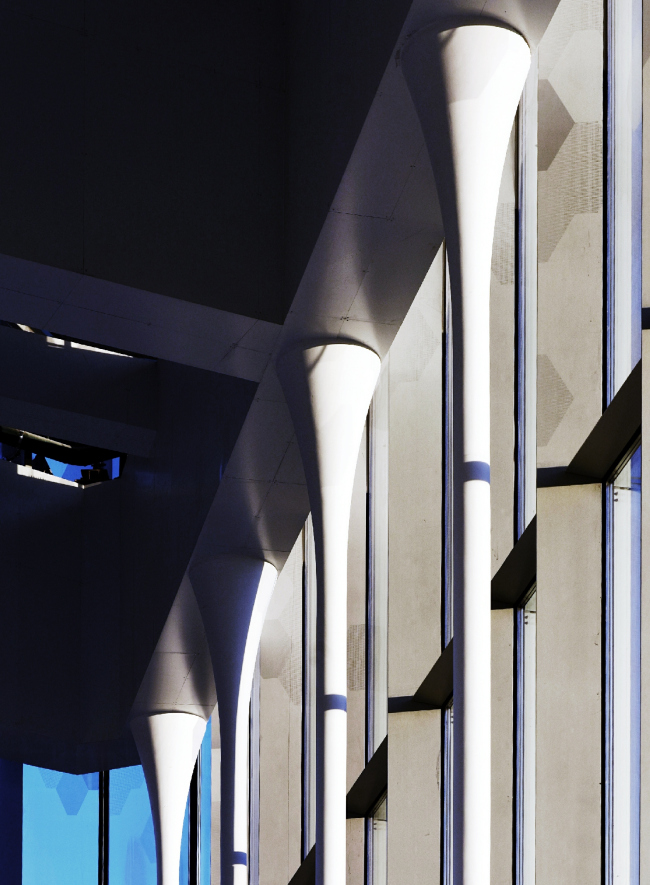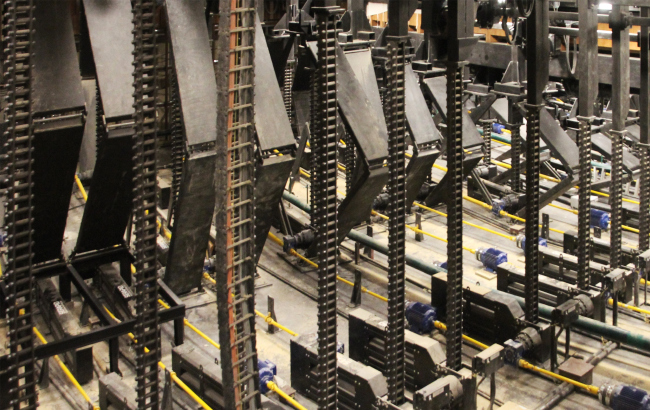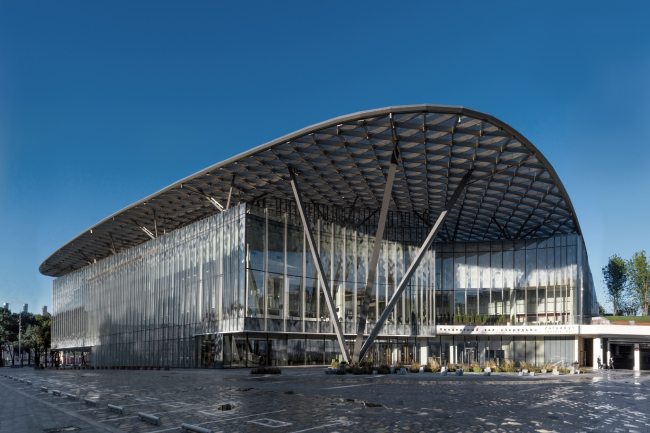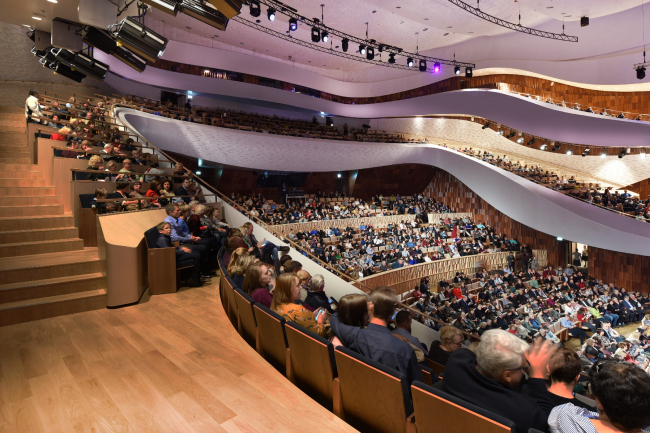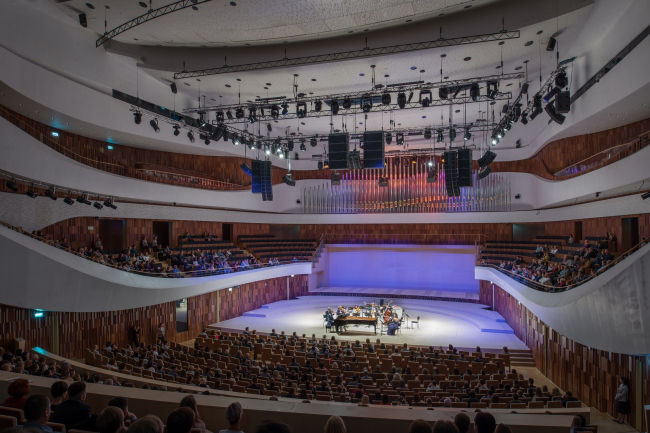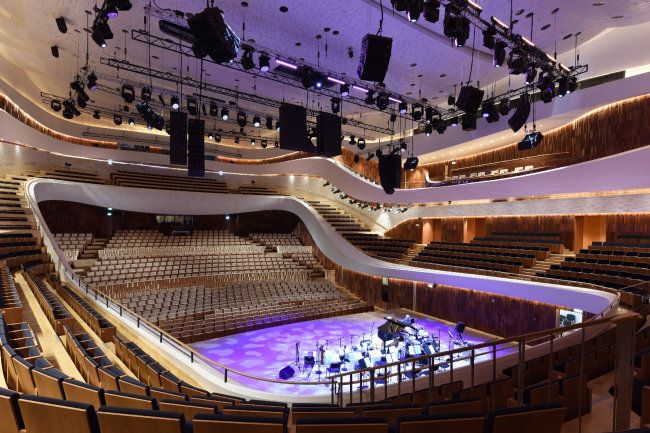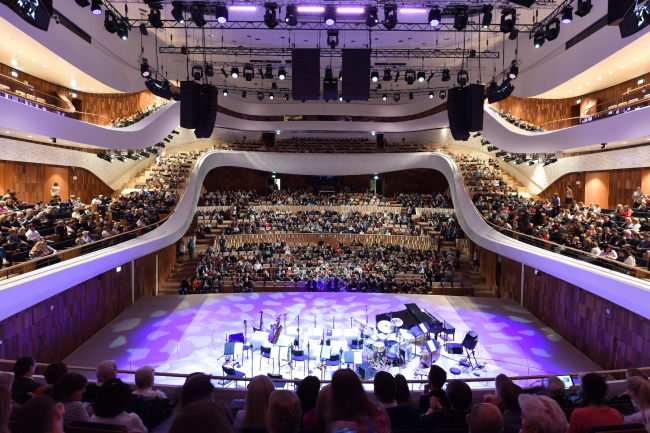|
Published on Archi.ru (https://archi.ru) |
|
| 15.10.2018 | |
|
The Crystal of Music |
|
|
Julia Tarabarina |
|
| Architect: | |
| Vladimir Plotkin | |
| Studio: | |
| AIG | |
| Creative Union ‘Reserve’ | |
|
The highly contemporary and technically sophisticated building of the philharmonic hall in Zaryadye Park combines interesting nonlinear solutions with a powerful retrospective of the sixties. At the same time, it is not conservative at all – rather, it can be understood as a metaphor or even “crystallization” of music, an art that is both emotional and mathematically abstract as well. The building of Valery Gergiev’s Zaryadye concert hall is not only a part of the ambitious project of Zaryadye Park but also a large and technically sophisticated project in its own right. By Moscow standards of the last two or three decades, it is also unique in terms of being fully implemented by its authors – Vladimir Plotkin and TPO Reserve with an active participation of the chief architect of Moscow, Sergey Kuznetsov – instead of being handed over to some other construction company after the approval of the project. As a result, Moscow got yet another grand-scale public building designed by one of the best Russian architectural firms and boasting the natural acoustics designed by the world-famous acoustician Yasuhisa Toyota, with a transformable hall and a luxurious giant foyer with plenty of light. Arguably, this is a breakthrough – especially if viewed against the backdrop of almost undisputed dominance of housing complexes in the national architectural context. Zaryadye Concert Hall. Photograph © Aleksey NaroditskyIt looks like a giant crystal layer between the outside world of the quiet drive behind the Kitaygorodskaya Wall and the inside world of the concert hall – the “cave” strewn with white ribbons of the balconies that spill over into the foyer with flexible protuberances of the staircase railings. This was one of the key ideas at one of the earliest stages of forming the concept of the project, which can be illustrated by the sketch done by Sergey Kuznetsov. Zaryadye Concert Hall. Photograph © Archi.ruNorthern granite rocks have quartz veins in them, and one gets quite a sensation when he sees, amidst the thick gray mass, a streak of something white, glittering and semitransparent. Generally speaking, this is precisely the effect that Zaryadye concert hall produces – something bright and glittering placed inside a rocky mount. A similar effect is produced by a diamond ring but I digress. The building looks as if it draws, out of the depth of the conditional Pskovskaya Mount (which used to be here in the days past), some threads of light – possibly, this is the image of music that shows through and is seen now like in a showcase. Zaryadye Concert Hall. Photograph © Aleksey NaroditskyZaryadye Concert Hall. Photograph © Aleksey NaroditskyZaryadye Concert Hall. The grid shell. Photograph © Aleksey NaroditskyZaryadye Concert Hall. Photograph © Aleksey NaroditskyZaryadye Concert Hall. Photograph © Aleksey NaroditskyIt is all the more surprising that all this was achieved by using comparatively modest means, without any excessive use of wow-architecture techniques. Yes, there is a fair share of nonlinearity in this building but its inner dialectics is ruled by laconic purity of statement of the classic modernism of the sixties, which simultaneously expresses Vladimir Plotkin’s author preferences and becomes the contextual homage to the now-demolished Rossiya Hotel. And suddenly you begin to see in the Zaryadye hills the grass-covered piles of debris remaining from the demolition of the giant building, and in the concert hall – its “underground” offshoot, like a branch of a cut-down tree. A very curious idea, even though it’s just a fantasy of mine. In actuality, for understanding the specifics of the modernist discourse that is transformed here, both the idea and the circumstances are equally important. First of all, the auditorium is guitar-shaped. The Russian acoustic experts still claim that the best option would be a simple rectangular auditorium, while the acousticians who worked with building before Yasuhisa Toyota also suggested that a hollow pocket should be created above the ceiling of the auditorium for better sound. Yasuhisa Toyota, however, rejected the pocket idea, proposing a “waist”. TPO Reserve came up with two fundamentally different stylistic approaches of designing the interior of the auditorium: initially, Vladimir Plotkin was inclined to accept the more laconic “clear-cut” shape but Valery Gergiev chose the other option, bright, and adorned with ribbons of the balconies. The authors accepted this solution and now they say that “they are lucky that it all ended up happening that way”. Zaryadye Concert Hall. Photograph © Aleksey NaroditskyA sketch by Sergey Kuznetsov, January 2015Zaryadye Concert Hall. Photograph © Aleksey NaroditskyZaryadye Concert Hall. Photograph © Ilia IvanovZaryadye Concert Hall. Photograph © Ilia IvanovHere is how it ended up happening: the balconies of the auditorium and the foyer, the bar counters of the cafés and the round columns all got merged together to form a single framework that is both bearing and image-making. It is all completely white, and its volume is not exactly concealed and not exactly accentuated either – rather, it’s been leveled out. There are two basic approaches to the shape of white objects: the inclined light can bring out their texture and plastique, whereas being lit from several sides, they become almost a colored spot, an element of a graphic image that is more about de-reification than plastique, quite light and not massive at all. The interior of Zaryadye concert hall rather belongs to the second approach. One will not see here a massive “flow of shapes” that we can see in Frank Gehry projects; there is no intrusion of plastique or a heavy flow mass like in the Ryabushinsky mansion, and even the dazzling white acrylic railings of the staircases look like wings of some unearthly substance. In other words, the digital, trendy and state-of-the-art “wow” pattern of the auditorium still did not subdue the original idea but got dissolved in it – lighting it up with its dynamics, keeping its graphic quality yet remaining quite light, laying the stress in the word “curvilinear” expressly on the “linear”. This is the way streams of air are drawn in the movies, and wisps of fog spread out. The effect of de-reification is helped not only by the white light reflected in the white surfaces but also the strokes of the insets in the foyer balconies, backlighting of the layered ceiling and the flexible ventilation “gills”. The glass lamellae on the outside, echoed by the slim ribs on the inside, and even the diamond-shaped pattern of silk printing all work together to enhance that “stroking” graphic effect. On a sunny day, this effect is enhanced even more by the mesh of shadows from the stained glass window sashes. Yet another type of strokes – let’s call it “light and shadow” type – appears in the halls because of the cuts, which are motivated by the acoustic requirements. In spite of their purely practical function, these little horizontal indents on the inside work in unison with the vertical light stripes on the outside, even making a curious pendant pair. Zaryadye Concert Hall. Photograph © Aleksey NaroditskyZaryadye Concert Hall. Photograph © Aleksey NaroditskyZaryadye Concert Hall. Photograph © Ilia IvanovZaryadye Concert Hall. Photograph © Ilia IvanovYet another version of the stroking pattern is vertical “pleating” of the outside walls of the main auditorium, which is turned to the foyer. As it gets closer to the staircases, one of the facets of each of the prisms of the corrugated pseudo-curtain turns into a mirror, which gives an effect of the maximum de-reification, an effect that is even stronger than one that just a single giant mirror would have produced – because a single mirror would have simply duplicated the space, whereas here, thanks to their alternating with mirror strips, the wood planks seem to be absolutely flat and hovering in space surrounded by the kaleidoscope of reality. In the middle, closer to the entrance doors, the mirror halves gradually come to naught – and it looks as if the “curtain” wall pulls itself up in front of our eyes, the way this could only look in cyberspace. Inside the auditorium, the regular “pleating” is echoed by a multitude of dark-colored mahogany ribs – but in the interior they look less pristine and are placed more chaotically, which, on the one hand, is good for the acoustics, and, on the other hand, looks like drawing charcoal shading or brushed velour, because it casts deep plush shadows. Thus, what we see is mahogany on either side, but on the outside it looks like silk or (because of the mirrors) moiré, whereas on the inside it looks like patent leather. This way, the wall is camouflaged “as a curtain” that surrounds the framework of the balconies. Meanwhile, in accordance with the acousticians’ requirements, all of the panels in both halls were made pretty thick – up to 20 centimeters – in order to ensure the correct spreading and reflection of sound. Incidentally, again, for better acoustic properties, instead of two minor halls, the architects designed only one, but with a high ceiling. Zaryadye Concert Hall. Photograph © Ilia IvanovZaryadye Concert Hall. Photograph © Ilia IvanovZaryadye Concert Hall. Photograph © Ilia IvanovZaryadye Concert Hall. Photograph © Ilia IvanovZaryadye Concert Hall. Photograph © Ilia IvanovYet another acoustic requirement put to rest the architects’ innovative idea of making the grand auditorium command a fine view of the Moskva River by making its south wall from glass, for the sake of which the axis of the auditorium was turned southward, parallel to the axis of one of the wings of the hovering bridge (and not perpendicular to the main façade, the way it is usually done). According to the original version, there was a glass wall behind the stage that would let the panorama of the Moskva River inside the auditorium like a stage backdrop, which is shown on one of the preliminary composition sketches. It turned out, however, that such a glass wall would make it impossible to achieve the desired sonic properties of the auditorium. Therefore, the south façade of the building got a stone-covered wall – the frame of a giant multimedia screen meant for broadcasting the concerts (well, or just commercials when there are no concerts going on). This way, the originally designed “window from the auditorium” got a mirror flip and turned into “window to the auditorium”. Anyway, the strokes are helping the white color, the light and the glass to de-reificate everything, to make everything seem light and lighter still. It also levels out the fanfare of the volumetric plastique: on the inside, we find ourselves not so much amidst volumes, as amidst lines, like in the middle of the tulle stage props, everything being drawn upon the layers of some sort of semitransparent fabric; the general effect is, of course, not exactly like this but very close to it: instead of closing in on you, the walls are withdrawing, proud of their transparency, like a curtain might do. Transparency is one of the key factors here – for the façades, the architects also selected the kind of glass that lets in as much ambient light as possible. The idea was not just to make a huge stained glass windows and show the panorama of the river, but to make a membrane wall, a barrier that would be felt as little as possible, growing up from the ground, while the floor would follow the slight slant of the terrain, smoothly descending on the direction of the Moskva River from north to south. Zaryadye Concert Hall. Photograph © Ilia IvanovZaryadye Concert Hall. Photograph © Ilia IvanovZaryadye Concert Hall. Photograph © Ilia IvanovJust as smoothly as the slopes that follow the terrain, there are ramps growing in the floor that run along the façade, making the lengthwise motion akin to the circling of the balconies – with just a minor slant, putting you into a strolling relaxed kind of mood. One must note that this attention to the natural terrain and paving techniques have recently become one of the main themes with TPO Reserve – as we remember, the pavement pattern is transferred not only on the floor but also on the glass of the windows as silk printing. All of this looks very high and light, higher and lighter than it looks from the outside – the effect is also enhanced by the fluorescent lights, the already mentioned strokes, lines and dots. The spotlights are installed in the ceiling and in the lower surfaces of the balconies, not in some regular order but in a seemingly freehand fashion. In the evening, the reflection of the interior is projected to the dark space outside, the spotlights looking like hovering stars calling out to the real celestial bodies invisible for the city observer – the effect is almost cosmic. At the same time, it looks as if the building were scattering around itself bright spangles, like with a magic wand, generating glittering dots flying into space. Inside the building, the spots of light are also multiplied by their reflections and produce an all-but-impalpable glow that nonetheless puts you in a magic mood. It is also supported by the thin corona lucis of the chandeliers, strewn with tiny lamps, each with a white semitransparent wing. The rehearsal hall. Zaryadye Concert Hall. Photograph © Aleksey NaroditskyA sketch by Vladimir Plotkin, January 2015Zaryadye Concert Hall. Photograph © Aleksey NaroditskyThis immersion into the space of lines is echoed by yet another effect – let’s call it “town in the snuff-box”. The main auditorium is transformable in many of its parts. And, although it is unable to open its south wall to show the river panorama, the balcony behind the stage can still be pulled out, which increases its depth. The pit stalls can also be removed, the orchestra amphitheater too, down to the even floor level. The transformations are driven by mechanisms hidden in the underground floor – very deep and spacious. Here everything is filled with chains and gears, and a layperson may think that this is the way the space under the escalator must look like in a metro station. The “mechanized” character of the concert hall becomes the nucleus for many of the aforementioned features of its architecture. Staying within a giant mechanism, or a virtual space, or the giant scenic pattern are things of a similar nature, they put us in a fairytale mood, which enhances the experience of going to a concert. The pleating of the outside wall of the hall, by the way, looks not only like a curtain but also like a giant gear (of the same “mechanical snuff-box”), while the alternation of the wooden and mirror panels is reminiscent of some studio works by Vladimir Plotkin – those of them, which were done on a computer, and in which all of the elements keep spinning like in a hadron collider. The imagery based on the idea of a frozen mechanism is characteristics of many Vladimir Plotkin projects – it’s more than a technique, it’s a theme. Zaryadye Concert Hall. Photograph © Aleksey NaroditskyZaryadye Concert Hall. Photograph © Aleksey NaroditskyZaryadye Concert Hall. Photograph © Aleksey NaroditskyZaryadye Concert Hall. Photograph © Aleksey NaroditskyMeanwhile, here is what the main effect is all about. In terms of its emotional background, its openness, its flowing shapes, and its work with light and materials, Zaryadye concert hall, especially its foyer, really resembles the landmark projects of modernism: The Moscow State Opera and Ballet Theatre, Pioneers’ Palace on Lenin’s Hills, and even (especially with its ribs down to the floor) the Kremlin Palace of Congresses. And it may seem that a lot of what the authors of those buildings dreamed about is polished here to perfection from the technical, and sometimes even from the artistic standpoint. Everything is pretty much the same but the windows are taller and more transparent, the white is whiter, the light is brighter, and the runs are thinner. What is going on in Zaryadye is some restraint of the power of modern technologies, which are placed, in spite of the numerous curves present here, into strict stereometric constraints – and the carefully calculated high-precision use of these technologies to explore the image that was outlined in the sixties. I cannot quite fond the term for this – this is something that is the opposite of the neomodernism of the 2000’s, maybe we should call it neo-neo? And, as a final stop, something like the author’s signature, Zaryadye offers us large brazen handles on the auditorium doors, which are flesh and blood of the 1960’s interior design, only larger and seemingly even more clearly cut. At the same time, there is also some flexibility present here: an author from the 1960’s, would have probably set into the hill some sort of a glass prism with corners boldly sticking out – but what we have here is a sort of a slant, a cantilevered structure, a crystal but definitely not a prism. Not only does the building immerse us into a semblance of some volumetric and graphic picture, making us sense the space in a different way, as well as feel differently, but it also immerses us into history to some extent – it even looks a lot like a remake, working pretty much like the new versions of “Star Wars” that, removing the naïveté of the earlier versions, hone to perfection the basic interesting ideas that were there in them. The architecture of the concert hall seems to be deliberately placed on the verge of neo and classic modernism; it probes the musical keys of its elements, creating something more than just the sum of its parts. Probably, this duality is resonant with the nature of music, an art where emotion is particularly strongly abstracted from reality. Music, as we know, is all about both math and emotion, it’s the most abstract art there is, and the concert hall designed by TPO Reserve can be considered to be the portrait of music, or at least one of the possible portraits. In any case, the balance between emotionality and abstraction that takes the listener to the “music of the spheres”, is undoubtedly there. Zaryadye Concert Hall. Photograph © Aleksey NaroditskyZaryadye Concert Hall. Photograph © Julia Tarabarina, Archi.ruZaryadye Concert Hall. Photograph © Ilia IvanovZaryadye Concert Hall. Photograph © Julia Tarabarina, Archi.ruZaryadye Concert Hall. Photograph © Ilia IvanovZaryadye Concert Hall. Photograph © Ilia IvanovZaryadye Concert Hall. Photograph © Aleksey NaroditskyZaryadye Concert Hall. Photograph © Aleksey NaroditskyZaryadye Concert Hall. Photograph © Ilia IvanovZaryadye Concert Hall. Photograph © Aleksey NaroditskyZaryadye Concert Hall. Photograph © Aleksey NaroditskyZaryadye Concert Hall. Photograph © Ilia IvanovZaryadye Concert Hall. Photograph © Ilia IvanovThe chandeliers in the foyer. Zaryadye Concert Hall. Photograph © Archi.ruZaryadye Concert Hall. Photograph © Ilia IvanovZaryadye Concert Hall. Photograph © Ilia IvanovZaryadye Concert Hall. Photograph © Ilia IvanovThe mechanisms in the underground part of Zaryadye Concert Hall. Photograph © Archi.ruZaryadye Philharmonic Hall. The layout of the mechanization © TPO ReserveZaryadye Philharmonic Hall. Section view 1-1 © TPO ReserveZaryadye Concert Hall. Photograph © Aleksey NaroditskyZaryadye Philharmonic Hall. Plan of the -1st floor © TPO ReserveZaryadye Philharmonic Hall. Plan of the 1st floor © TPO ReserveZaryadye Philharmonic Hall. Plan of the 2nd floor © TPO ReserveZaryadye Concert Hall. Photograph © Ilia IvanovZaryadye Concert Hall. Photograph © Aleksey NaroditskyZaryadye Concert Hall. Photograph © Aleksey NaroditskyZaryadye Concert Hall. Photograph © Ilia IvanovZaryadye Concert Hall. Photograph © Ilia Ivanov |
|

